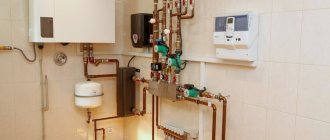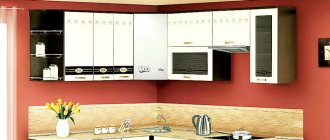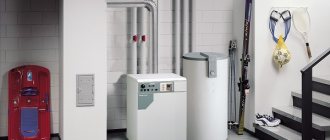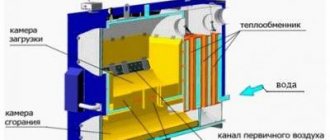The concepts single-circuit or double-circuit mean that the heating boiler has either one main (primary) water circuit intended exclusively for heating, or is equipped with an additional (secondary) circuit intended for hot water supply - DHW. Accordingly, single-circuit boilers can only provide heating for a house, while double-circuit boilers, having the same dimensions, can provide both heating and sanitary water heating for the bathroom and kitchen.
It would seem that double-circuit boilers are definitely better, because they are more practical and functional, but in practice everything is not so simple and before choosing, we recommend that you carefully weigh all the operating features, the pros and cons of each equipment, which we will describe in this article.
What is a double-circuit gas boiler
A double-circuit gas boiler is an installation that is a device capable of producing energy in the form of heat created by burning gas. This energy heats the coolant, which passes through the core of the boiler and goes further, obeying natural or forced circulation in the heating circuit, and also heats the water in the boiler and used for household needs.
There are two types of such boilers:
- double-circuit wall-mounted gas boiler;
- gas boiler, double-circuit, floor-standing.
Such a heating structure consists of the following elements:
- gas stove;
- igniter first and main;
- heat exchanger;
- heating circuit;
- DHW circuit;
- a pipe used as a chimney through which combustion products are ventilated;
- expansion tank;
- pump that creates circulation;
- automatic device that controls the boiler;
- safety monitoring device.
All of the above elements are collected in a single box. It is covered on top with a metal plate, usually available in two colors:
- white;
- metal.
The housing is attached to the wall with the bolts included in the kit, and the unit is sold assembled with the necessary adapters so that the boiler can be installed in the heating system. The equipment usually depends on the model.
Combustion chamber and smoke exhaust system
Dual-circuit gas heating systems are characterized by two design types:
- with an open combustion chamber;
- with a closed combustion chamber.
Boiler equipment with an open combustion chamber is low-performance due to the use of natural convection, and requires constant ventilation of the room. It is more suitable for small country houses.
Boilers with a closed combustion chamber are high-performance devices. They take in outside air to form a combustible mixture. This reduces the impact of the unit on the microclimate in the room where the device is installed.
Air is pumped by a special fan. Therefore, the devices are perfect for large and medium-sized residential premises with the need for domestic hot water.
A passive smoke exhaust system is unsafe, and therefore forced exhaust is widely used. Solutions with coaxial chimneys (of the “pipe-in-pipe” type) have also become widespread. This design simplifies the installation process. The coaxial pipe simultaneously takes in air and removes combustion products.
Specifications
Due to their external aesthetic qualities, double-circuit gas boilers fit perfectly into any interior design.
Technical data suggests that such a device can simultaneously function in two areas, such as:
- heating water;
- space heating.
If the user purchases a wall-mounted gas boiler, then he significantly saves usable space and there is no need to build a separate room for the selected model. If it is necessary to place a floor-standing boiler, then it is necessary to build, in accordance with all the rules, a separate building in which the boiler room will be located.
The most important advantage of double-circuit gas boilers is that they have the technical ability to connect a boiler, which single-circuit units do not have. To heat the water there is a water heater that works like a flow-through one.
The power of such devices ranges around 30 kW.
The heated area should be no more than 180-280 square meters. m.
According to manufacturers' recommendations, it is worth installing such a system as close as possible to the points where water will flow, so that the heating process begins immediately. It is also necessary to place rooms one after another where hot water will be distributed.
It is extremely inefficient to install points with hot water distributors in different directions, because then it will take much more fuel to warm up and supply water at the required temperature.
You might be interested in >> How to place a gas boiler room in your home?
Device
The main components and parts of double-circuit boilers are:
- gas burner and primary heat exchanger combined with it;
- gas equipment - supply unit, valve, other elements;
- secondary heat exchanger;
- three-way valve;
- turbocharger fan;
- circulation pump;
- expansion tank;
- control board and self-diagnosis sensors.
Boilers created using traditional “open” technology do not have a turbocharging fan, since their smoke removal occurs according to the principle of natural draft, and the air comes directly from the surrounding atmosphere.
Types of double-circuit gas boilers
The type of gas boilers is divided according to several criteria:
- According to the principles of using combustion products:
- convection;
- condensation
- According to the design provided in the heat exchanger:
- separate;
- bithermic.
- By type of combustion chamber:
- closed;
- open.
The first type has a number of advantages and disadvantages, namely the fact that thermal energy is not used to its full potential is attributed to the disadvantages. The advantages include relative ease of use and budget price.
The advantages of the second type include a separate design, since if any of the parts fails, it can be replaced - this will be very problematic with a monolithic block. The disadvantages include the following: when a person takes a shower, the water must be turned on a little in advance, because it heats up to such an extent that you can get a thermal burn.
For combustion chambers, a closed type chamber is preferable, as it is safer.
Conclusion
To understand how to choose a double-circuit boiler, you need to remember that gas boilers, like any other equipment, have their disadvantages and advantages. First of all, you should rely on your personal budget, and only then study the advantages of a particular system
Above are recommendations and evaluation of popular double-circuit designs. By studying them, you will definitely come to the right choice. Also visit popular online stores to find out the price and possibly find the right solution.
28.06.2017
Return to list
Principle of operation
Such boilers are the most interesting and budget option for heating a home, since gas is one of the cheapest types of fuel. Even if we compare the costs incurred by a house in which there are many apartments, then in the case when it is connected to the gas main, the economic cost item will be much lower than where everything is based on power from electrical networks.
By moving to a permanent place of residence outside the city and connecting gas to their heating system, people save significantly, since they pay, instead of mythical utilities, the real price for the availability of fuel. At the same time, the owners can regulate the duration of fuel use themselves, that is, turn the device on and off as needed. Because the operating principle of such an installation as a gas double-circuit boiler for heating a private house is as follows:
- A double-circuit gas installation, if it is installed in a wall-mounted version, then it is not very important where it will be located. But if a floor-standing option is used, then a separate boiler room will be needed. But there are two important points. Firstly, it must be possible to connect the boiler to the main gas, and secondly, it is necessary to install a chimney system through which combustion products, such as smoke and carbon monoxide, will freely escape outside.
- Also, a thermal circuit must be connected to the boiler, through which the coolant (water or antifreeze) will circulate; such pipes are usually marked with blue arrows in the direction in which the fluid circulates.
- Hot water is distributed as follows to the bathroom or shower; And after that the circuit closes. That is, such premises should be located one after another, priority is not important here.
- for kitchen needs;
- and in other places where it is also necessary to supply water.
- The pump, which helps the coolant circulate, is in most cases structurally located inside the heating installation. It sets the movement of the heated liquid inside the circuit.
- The type of objects that accumulate heat may vary depending on the model of the boiler unit itself. The following types of batteries are sometimes used:
- conventional radiators;
- warm water floor;
- any convectors;
- It is also possible to connect additional elements, such as a heated towel rail.
You might be interested >> Autonomous heating and gas boilers
That is, from this diagram it becomes clear that about five different pipes are connected to a double-circuit gas boiler, regardless of its type:
- Main gas.
- The circuit to which the heated coolant is supplied, then follows through all heating points.
- Return.
- Tap water, or rather, providing an entrance for it. The outlet pipe through which hot water flows to the distribution unit and is then directed to water intake points, providing the ability to obtain hot water for a variety of needs.
As for the choice of coolant, it is necessary to consider the manufacturer’s recommendations. Because in a double-circuit unit it is permissible to use different coolants, but it all depends on the type of boiler, because, for example, antifreeze can be used in a cast-iron boiler, but in others it is undesirable.
Do you need a boiler?
A double-circuit boiler is capable of independently preparing hot water and does not require additional devices . This is a common view, and it is generally correct.
However, many users are not satisfied with the DHW supply mode in their homes. This usually happens due to a large number of water taps, numerous families, etc. For these cases, there is a way to connect an external drive as a buffer capacity.
Hot water fills the container and is replenished as needed.
The boiler's DHW supply can be adjusted so that the flow rate is minimal . This will ensure high temperatures and stabilize the supply of hot water to consumers.
Advantages and disadvantages of a double-circuit gas boiler
Such gas installations have very impressive advantages:
- the user can, using a single unit, both heat the house and heat water for any purpose;
- no need to buy a boiler separately;
- the installation is quite compact;
- the wall version generally fits perfectly into the interior design of the corridor or kitchen;
- significant savings on utility bills;
- convenient adjustment of water temperature.
But, despite these advantages, there are still disadvantages, and they should be taken into account:
- if you simultaneously use hot water at several liquid outlet points, the heating efficiency of the main coolant will significantly decrease for a short time;
- the volume of hot water will depend on the size of the boiler;
- it is necessary to install filters at the liquid inlet inside the heat exchanger, because if the water is of low quality, then the holes in the heat exchanger themselves become dirty and break quite quickly.
Organization of hot water heating in boilers with one circuit
Despite numerous desires, it is impossible to turn a single-circuit boiler into a double-circuit one in the literal sense of the phrase. But you can retrofit a single-circuit boiler with an indirect heating boiler, sacrificing space and money, but providing hot water supply without all the disadvantages of double-circuit boiler models.
VIESSMANN gas floor-standing boiler in combination with a Vitocell-V 100 indirect heating boiler for 200 l.
The principle of operation is simple: inside the boiler with sanitary water there is a coil of the water heating circuit of the boiler; the coolant constantly circulates through the coil (as throughout the entire heating system of the house), maintaining a constant temperature. With this scheme, it is possible to ensure a relatively stable hot water supply not only when using a gas or electric, but even a solid fuel single-circuit boiler. With basic knowledge and skills, you can carry out the modification yourself.
Indirect heating boilersDouble-circuit BoilersSingle-circuit
Features of installing such a boiler
When installing a gas boiler, many important points must be observed to ensure safe and accurate operation of the heating installation:
- The installation location of the unit must be approved by gas services and comply with all standards.
- The system connection project must initially be drawn up on paper and then agreed upon with the gas company employees.
- Specialists from the relevant service must install meters to monitor fuel consumption.
- Before installing the boiler, it is recommended to check its complete configuration.
- First, you should mark on the surfaces all the points where the equipment will be installed.
- Next, connect all systems in series.
- After this, the first test filling of the circuit with coolant is carried out.
- Then a test firing of the boiler is carried out.
- If there are any problems during the first start-up or you smell gas, it is better to call a specialist to inspect the system.
Most popular manufacturers
European companies are considered the most reliable and popular manufacturers.
These include:
- Vaillant;
- Viessmann;
- Navien;
- BAXI;
- Protherm;
- Buderus;
- Bosch, etc.
The list can be continued for a long time, but there is little point in listing the names of companies. on the market, offering their developments and models .
This allows you to choose the most suitable boiler with the required parameters.
What are the differences?
Single- and double-circuit boilers have common elements. But if the pipelines or gas burners are almost the same, then the heat exchanger differs in design.
In single-circuit devices, a simple type is installed, representing a pipe. Dual-circuit models often use thermal systems. That is, the pipe is placed in another one with a larger diameter. This allows you to create 2 circuits needed to perform the functions.
The difference is the 3-way valve. Basically, these are installed only in dual-circuit models. Three-way valves are designed to change the direction of hot water. Therefore, when using liquid for domestic needs, heating of the room stops. The valve shuts off the coolant supply to the radiators.
How to calculate power?
Calculating boiler power is too complex a task. An unprepared person cannot cope with it . However, there is a simple calculation option that gives an approximate, but quite acceptable result.
Heating 10 m2 of area requires 1 kW of thermal energy. Based on this ratio, you can quickly determine the required boiler power. For example, for a house of 200 sq.m. you need 20 kW of thermal energy.
A unit of either 18 or 24 kW is suitable.
NOTE!
You should not make a large power reserve, since the boiler begins to operate at minimum mode. Frequent starting and stopping of the burner contributes to the rapid failure of components, and scale accumulates in the heat exchanger. The result will be the need for expensive repairs or the purchase of a new boiler.











